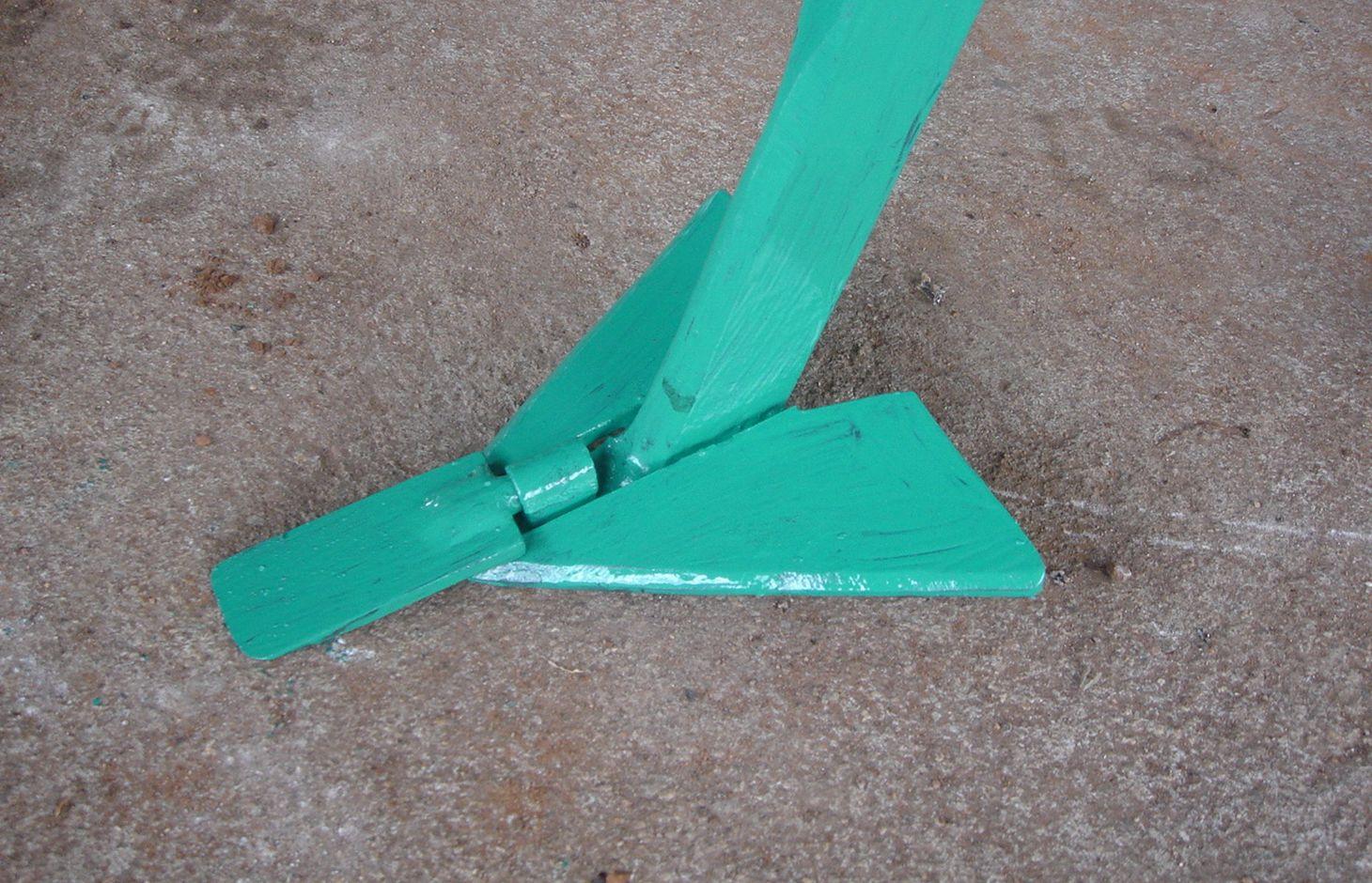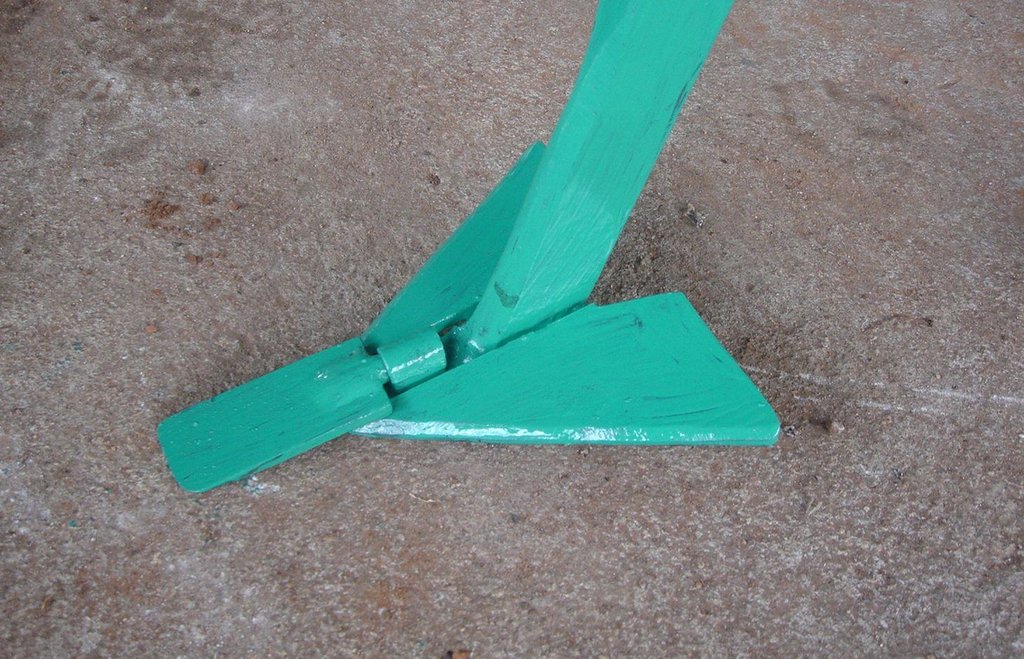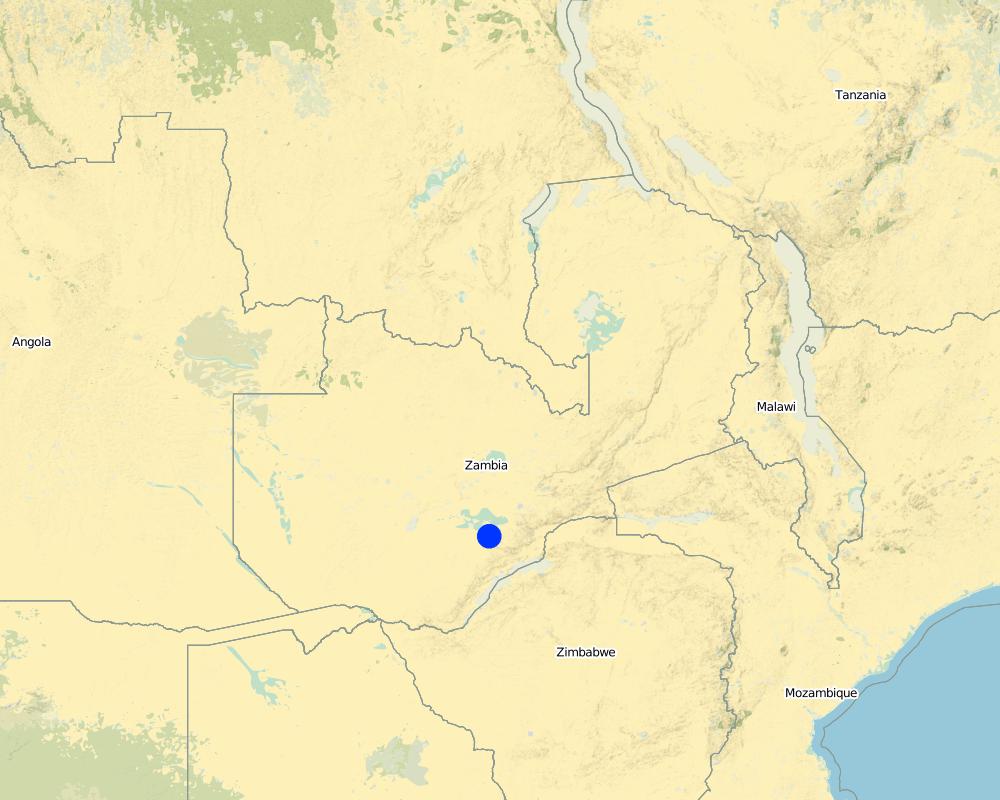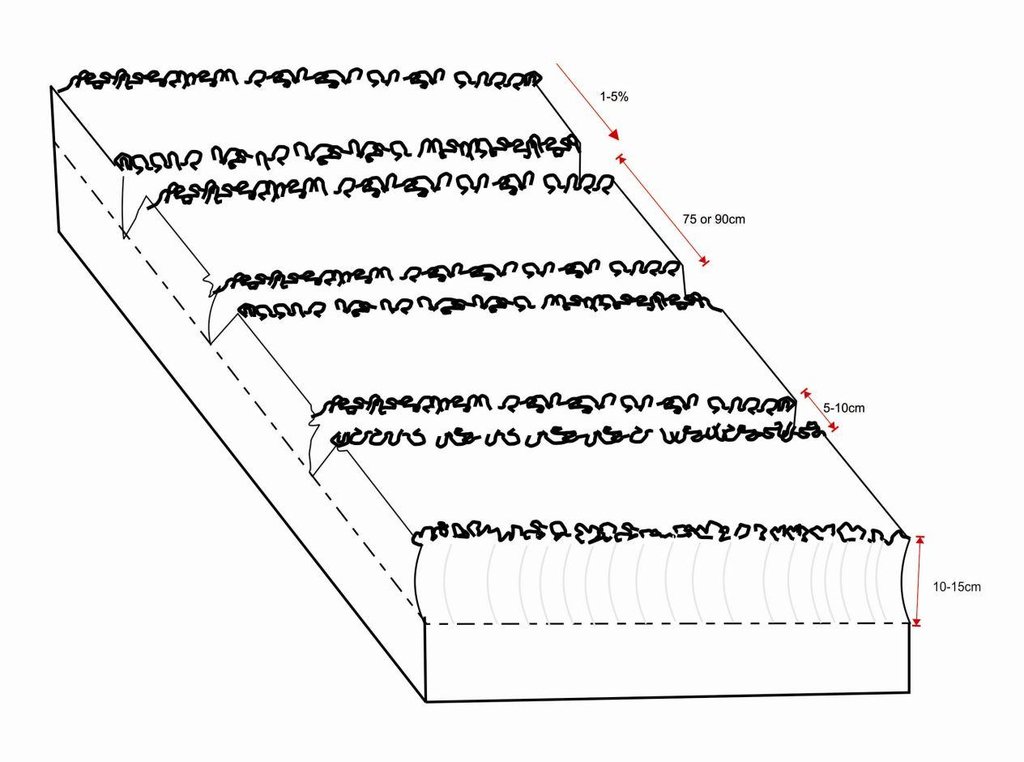Strip Tillage Conservation Farming [赞比亚]
- 创建:
- 更新:
- 编制者: Silenga Wamunyima
- 编辑者: –
- 审查者: David Streiff, Alexandra Gavilano
technologies_1187 - 赞比亚
查看章节
全部展开 全部收起1. 一般信息
1.2 参与该技术评估和文件编制的资源人员和机构的联系方式
SLM专业人员:
Ndandula Sharon
Golden Valley Agricultural Research Trust
赞比亚
SLM专业人员:
Katoweji Alfred
Golden Valley Agricultural Research Trust
赞比亚
SLM专业人员:
有助于对技术进行记录/评估的机构名称(如相关)
Golden Valley agricultural research trust (Golden Valley agricultural research trust) - 赞比亚1.3 关于使用通过WOCAT记录的数据的条件
编制者和关键资源人员接受有关使用通过WOCAT记录数据的条件。:
是
1.5 参考关于SLM方法(使用WOCAT记录的SLM方法)的调查问卷
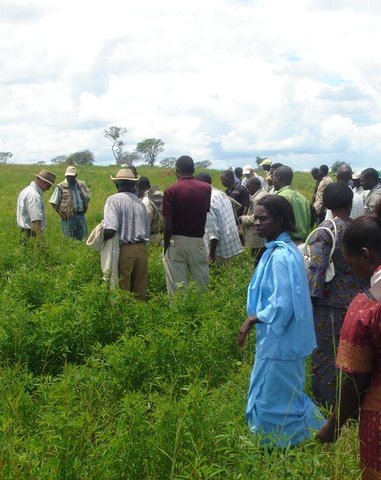
Participatory Research and Development [赞比亚]
This is a collaborative process between researchers and farmers for developing and adapting new technologies that focus on incorporating the perspectives and inputs from the farmers into the development process.
- 编制者: Arthur Chomba
2. SLM技术的说明
2.1 技术简介
技术定义:
Strip Tillage Conservation Farming is an animal draft reduced tillage method that involves loosening a strip of soil with a strip tillage tool so as to reduce soil disturbance and improve soil and water conservation.
2.2 技术的详细说明
说明:
The strip tillage tool is an adaptation of a Magoye Ripper but is meant to be used in moist soil. In the strip tillage tool, sub-surface wings are attached to the ripper tine to increase the width of soil disruption which the ripper will be unable to achieve in moist soil. The sub-surface wings loosen the soil by lifting it slightly and letting it fall in place without inverting it. In this way, a strip of soil with a width of around 20cm is tilled up to 20cm deep and this is where the crop will be planted. The region between the strips is maintained as a no-till region for soil and water conservation.
Purpose of the Technology: The strip tillage tool is meant to be a transitional technology for farmers intending to adopt Conservation Agriculture (CA) in degraded soils. These soils will need routine loosening while the biological activities allow the soil structure to recover sufficiently until tillage is no longer required. Strip tillage is able to achieve deeper soil loosening with much less draft force, wear of tines and soil disturbance than ripping. The untilled region between the strips enables the benefits of soil cover such as improved infiltration, soil water storage and increased soil organic matter. Soil loosening by strip tillage does not produce large clods like ripping does but instead produces a fine seedbed that enables uniform emergence of the crop, and this together with the deep penetration results in early plant vigour. The strip tillage implement is also designed to allow the attachment of a planter unit to enable tillage and planting in one operation.
Establishment / maintenance activities and inputs: The establishment of strip tillage based conservation agriculture mainly involves the purchase of the strip tillage implement and the replaceable tines. Liming acidic soils (low pH soils) followed by a final ploughing will be required to correct the soil PH which otherwise will be difficult to correct once conservation tillage has been established. Maintenance activities include strip-tilling the soil which may or may not include planting and fertilizing in the same operation. Weeding should preferably include the use of herbicides, implying that the major operations will include spraying. In addition to the normal conventional inputs, herbicides will also become a major input and cost.
Natural / human environment: The strip tillage technology is most suited to the bigger small-scale farmers with a capacity of 5ha to about 20ha. The strip tillage tool together with the planter will require a relatively substantial investment and only the bigger farmers will fully utilize its capacity. The strip tillage action will not be very effective in wet soils especially in the heavier soils, soil disruption is best achieved when the soil is slightly moist but not too dry as to require to high draft forces. Strip tillage is useful in soil with poor structure that will require routine loosening to maintain yields while the soil is being rehabilitated.
2.3 技术照片
2.5 已应用该技术的、本评估所涵盖的国家/地区/地点
国家:
赞比亚
区域/州/省:
Zambia/Southern Province
有关地点的进一步说明:
Mazabuka/Magoye
具体说明该技术的分布:
- 均匀地分布在一个区域
如果不知道精确的区域,请注明大致覆盖的区域:
- 0.1-1 平方千米
注释:
The strip tillage technology is only in its second year of promotion and 7 farmers had adopted the technology in the 2011/12 season. The field sizes range from 1ha to 30ha.
Map
×2.6 实施日期
如果不知道确切的年份,请说明大概的日期:
- 不到10年前(最近)
2.7 技术介绍
详细说明该技术是如何引入的:
- 在实验/研究期间
注释(项目类型等):
Development of the strip tillage technology began in 2008 in response to farmers’ feedback from the promotion of another conservation agricultural technology, the Magoye Ripper. The technology was introduced to the farmers in 2011.
3. SLM技术的分类
3.1 该技术的主要目的
- 减少、预防、恢复土地退化
3.2 应用该技术的当前土地利用类型
同一土地单元内混合使用的土地::
是
具体说明混合土地使用(作物/放牧/树木):
- 农牧业(包括农牧结合)

农田
- 一年一作
年作 - 具体指明作物:
- 谷物类 - 玉米
- 纤维作物 - 棉花
- 油料作物 - 花生
每年的生长季节数:
- 1
具体说明:
Longest growing period in days: 135; Longest growing period from month to month: Mid November to end of March

牧场
动物类型:
- 牛 - 奶制品
- 山羊
- 家禽

森林/林地
注释:
Livestock density (if relevant):
1-10 LU /km2
Principaux problèmes d'utilisation des sols (opinion du compilateur): perte de structure du sol et perte de fertilité du sol
Principaux problèmes d'utilisation des terres (perception des utilisateurs fonciers): sécheresses et périodes de sécheresse
L'élevage pèche sur les résidus de récoltes
3.4 供水
该技术所应用土地的供水:
- 雨养
3.5 该技术所属的SLM组
- 最小的土壤扰动
3.6 包含该技术的可持续土地管理措施

农艺措施
- A2:有机质/土壤肥力
- A3:土壤表面处理
- A6:残株管理
- A7:其它
A3:区分耕作制度:
A 3.1:免耕
A6:对残株管理作出具体说明:
A 6.1:焚烧
注释:
Specification of other agronomic measures: Zero till, Crop Residue
Type of agronomic measures: early planting, mulching, manure / compost / residues, mineral (inorganic) fertilizers, soil conditioners (lime, gypsum), rotations / fallows, breaking compacted topsoil, minimum tillage, non-inversion tillage, breaking compacted subsoil
3.7 该技术强调的主要土地退化类型

土壤水蚀
- Wt:表土流失/地表侵蚀

化学性土壤退化
- Cn:肥力下降和有机质含量下降(非侵蚀所致)

物理性土壤退化
- Pc:压实
- Pk:熟化和结壳
- Pi:覆土

生物性退化
- Bl:土壤寿命损失
注释:
Secondary types of degradation addressed: Wt: loss of topsoil / surface erosion
Main causes of degradation: soil management (over ploughing, soil nutrient mining), crop management (annual, perennial, tree/shrub) (Monocropping of Maize), overgrazing (overgrazing of crop residues), poverty / wealth (Charcoal burning, under application of fertilizer)
Secondary causes of degradation: deforestation / removal of natural vegetation (incl. forest fires) (charcoal burning, openning up new land for agriculture), Heavy / extreme rainfall (intensity/amounts) (high intensity storms resulting in soil erosion and leaching), land tenure (over-exploitation of communal land), governance / institutional (lack of credit facilities)
3.8 防止、减少或恢复土地退化
具体数量名该技术与土地退化有关的目标:
- 减少土地退化
- 修复/恢复严重退化的土地
注释:
Secondary goals: prevention of land degradation
4. 技术规范、实施活动、投入和成本
4.1 该技术的技术图纸
技术规范(与技术图纸相关):
Planting lines are done at a depth of 15-20cm with inter row of 75 or 90cm. The width of the open furrow is 5-10cm wide. Planting rows are done across the slope to reduce runoff, these planting rows may be made in the dry season or during the rainy season when the soil is moist.
Location: Magoye. Mazabuka/Southern Province/Zambia
Date: 2014-06-29
Technical knowledge required for field staff / advisors: high (must be able to troubleshoot and advise the farmers on how to adapt the technology to fit into their production systems.)
Technical knowledge required for land users: moderate (knowledge of soil health management required when adopting the practice)
Main technical functions: control of raindrop splash, improvement of ground cover, improvement of topsoil structure (compaction), improvement of subsoil structure (hardpan), increase in organic matter, increase of infiltration, increase / maintain water stored in soil
Secondary technical functions: improvement of surface structure (crusting, sealing), increase in nutrient availability (supply, recycling,…), increase of groundwater level / recharge of groundwater, water harvesting / increase water supply
Early planting
Material/ species: Maize, Cotton
Quantity/ density: 44,000 pla
Remarks: 25cm intra row x 75cm
Mulching
Material/ species: Crop residues
Quantity/ density: 3ton/ha
Remarks: Uniformly spread
Manure / compost / residues
Material/ species: crop residues
Quantity/ density: 3ton/ha
Remarks: uniformly spread
Mineral (inorganic) fertilizers
Material/ species: basal and top dressing
Quantity/ density: 800kg/ha
Remarks: spot application
Soil conditioners (lime, gypsum)
Material/ species: lime
Quantity/ density: 1ton/ha
Remarks: every 2-3 years
Rotations / fallows
Material/ species: rotations of maize, cotton, cowpeas
Breaking compacted topsoil
Material/ species: strip tillage
Quantity/ density: 20cm deep
Minimum tillage
Material/ species: strip tillage
Non-inversion tillage
Material/ species: strip tillage
Breaking compacted subsoil
Material/ species: strip tillage
作者:
Silenga Wamunyima, Box 670577, Mazabuka, Zambia
4.2 有关投入和成本计算的一般信息
具体说明成本计算所用货币:
- 美元
注明雇用劳工的每日平均工资成本:
2.40
4.3 技术建立活动
| 活动 | 时间(季度) | |
|---|---|---|
| 1. | Strip Tillage implement | |
| 2. | Knapsack Sprayer |
4.4 技术建立所需要的费用和投入
| 对投入进行具体说明 | 单位 | 数量 | 单位成本 | 每项投入的总成本 | 土地使用者承担的成本% | |
|---|---|---|---|---|---|---|
| 设备 | Strip Tillage implement | pieces | 1.0 | 500.0 | 500.0 | 100.0 |
| 设备 | Knapsack Sprayer | pieces | 1.0 | 80.0 | 80.0 | 100.0 |
| 技术建立所需总成本 | 580.0 | |||||
| 技术建立总成本,美元 | 580.0 | |||||
注释:
Duration of establishment phase: 2 month(s)
4.5 维护/经常性活动
| 活动 | 时间/频率 | |
|---|---|---|
| 1. | Slashing and spreading crop residues | May-June yearly after harvest |
| 2. | Liming soil | Nov-Dec every 3 years |
| 3. | strip tillage, planting and fertilizing | Nov-Dec at onset of rain |
| 4. | Chemical weeding | 3 times per season |
| 5. | Harvesting | April-May |
4.6 维护/经常性活动所需要的费用和投入(每年)
| 对投入进行具体说明 | 单位 | 数量 | 单位成本 | 每项投入的总成本 | 土地使用者承担的成本% | |
|---|---|---|---|---|---|---|
| 劳动力 | Slashing and spreading crop residues | persons/day/ha | 8.0 | 2.5 | 20.0 | 100.0 |
| 劳动力 | Liming soil | persons/day/ha | 2.0 | 2.5 | 5.0 | 100.0 |
| 劳动力 | Strip tillage, planting and fertilizing | persons/day/ha | 4.0 | 2.5 | 10.0 | 100.0 |
| 劳动力 | Chemical weeding (sprayers) | persons/day/ha | 24.0 | 1.0 | 24.0 | 100.0 |
| 设备 | Animal traction | ha | 1.0 | 40.0 | 40.0 | 100.0 |
| 植物材料 | Seeds | kg/ha | 20.0 | 2.5 | 50.0 | 100.0 |
| 肥料和杀菌剂 | Fertilizer | kg/ha | 400.0 | 0.8 | 320.0 | 100.0 |
| 肥料和杀菌剂 | Herbicides | l/ha | 5.0 | 6.0 | 30.0 | 100.0 |
| 施工材料 | Lime | kg | 1000.0 | 0.042 | 42.0 | 100.0 |
| 其它 | Labour: Chemical weeding (sprayers) | persons/day/ha | 10.0 | 4.0 | 40.0 | 100.0 |
| 其它 | Labour: Harvesting | persons/day/ha | 10.0 | 4.0 | 40.0 | 100.0 |
| 技术维护所需总成本 | 621.0 | |||||
| 技术维护总成本,美元 | 621.0 | |||||
注释:
Machinery/ tools: Strip tillage planter
Calculations are for 1 ha of maize under strip tillage based conservation tillage and costs are for the Zambia situation in Magoye as of August 2012.
4.7 影响成本的最重要因素
描述影响成本的最决定性因素:
The weed control method employed is the main determinate factor depending on whether the farmer uses hand hoe or herbicides for weeding. Weed densities are higher in unploughed fields increasing the labour requirements/costs by a factor of about 5 if hand weeding is used instead of herbicides. Another major recurrent cost is that of fertilizer which makes up about half the cost hence the total cost will vary significantly depending on fertilizer cost.
5. 自然和人文环境
5.1 气候
年降雨量
- < 250毫米
- 251-500毫米
- 501-750毫米
- 751-1,000毫米
- 1,001-1,500毫米
- 1,501-2,000毫米
- 2,001-3,000毫米
- 3,001-4,000毫米
- > 4,000毫米
有关降雨的规范/注释:
Summer rains from November to March
农业气候带
- 半干旱
Thermal climate class: subtropics. 3 distinct seasons – summer, winter and one rainy season
5.2 地形
平均坡度:
- 水平(0-2%)
- 缓降(3-5%)
- 平缓(6-10%)
- 滚坡(11-15%)
- 崎岖(16-30%)
- 陡峭(31-60%)
- 非常陡峭(>60%)
地形:
- 高原/平原
- 山脊
- 山坡
- 山地斜坡
- 麓坡
- 谷底
垂直分布带:
- 0-100 m a.s.l.
- 101-500 m a.s.l.
- 501-1,000 m a.s.l.
- 1,001-1,500 m a.s.l.
- 1,501-2,000 m a.s.l.
- 2,001-2,500 m a.s.l.
- 2,501-3,000 m a.s.l.
- 3,001-4,000 m a.s.l.
- > 4,000 m a.s.l.
5.3 土壤
平均土层深度:
- 非常浅(0-20厘米)
- 浅(21-50厘米)
- 中等深度(51-80厘米)
- 深(81-120厘米)
- 非常深(> 120厘米)
土壤质地(表土):
- 中粒(壤土、粉土)
- 细粒/重质(粘土)
表土有机质:
- 低(<1%)
如有可能,附上完整的土壤描述或具体说明可用的信息,例如土壤类型、土壤酸碱度、阳离子交换能力、氮、盐度等。:
Soil fertility is low - medium and low fertility caused mainly by poor soil management practices, otherwise soils are inherently fertile.
Topsoil organic matter: Due to excessive ploughing and under fertilization
Soil drainage / infiltration is good - medium. Soils are naturally well drained but become less so after compaction due to ploughing
Soil water storage capacity is medium. Soils mostly loam to sandy loam with medium storage capacity
5.4 水资源可用性和质量
地下水位表:
> 50米
地表水的可用性:
中等
水质(未处理):
不良饮用水(需要处理)
关于水质和水量的注释和进一步规范:
Ground water table: Hand wells are <20m but reliable boreholes are > 50m
Availability of surface water: Mostly seasonal streams and dams
Water quality (untreated):Good when from communal hand-pumps and poor when from hand-dug wells.
5.5 生物多样性
物种多样性:
- 中等
5.6 应用该技术的土地使用者的特征
生产系统的市场定位:
- 生计(自给)
- 混合(生计/商业)
非农收入:
- 收入的10-50%
相对财富水平:
- 非常贫瘠
- 贫瘠
个人或集体:
- 个人/家庭
机械化水平:
- 手工作业
- 畜力牵引
性别:
- 男人
说明土地使用者的其他有关特征:
Land users applying the Technology are mainly common / average land users
Difference in the involvement of women and men: The technology is applied mostly by men since most households are headed males and animal traction operation are reserved for men. Planting and weeding operations are the domain of women and children
Population density: 10-50 persons/km2
Annual population growth: 3% - 4%
8% of the land users are rich and own 15% of the land (own more than 10 cattle).
8% of the land users are average wealthy and own 15% of the land (own 5 - 10 cattle).
16% of the land users are poor and own 20% of the land (less than 5 cattle).
68% of the land users are poor and own 40% of the land (do not own cattle).
Off-farm income specification: sale of rainfed crops makes up about half of their income, the remainder coming from sale of livestock, petty trading, hiring out labour and remittances
Market orientation of production system: Livestock, maize and legumes for home consumption/subsistence and sale of excess maize and cotton, dairy products (mixed).
Level of mechanization: Manual labour only for small backyard fields. Families without cattle borrow or hire
5.7 应用该技术的土地使用者使用的平均土地面积
- < 0.5 公顷
- 0.5-1 公顷
- 1-2 公顷
- 2-5公顷
- 5-15公顷
- 15-50公顷
- 50-100公顷
- 100-500公顷
- 500-1,000公顷
- 1,000-10,000公顷
- > 10,000公顷
这被认为是小规模、中规模还是大规模的(参照当地实际情况)?:
- 小规模的
注释:
Cropland: 1-2 ha (families without oxen), 2-5 ha (families with one pair of oxen), 5-15 ha (families with over five oxen)
Grazing land: 5-15 ha, 15-50 ha, 50-100 ha
5.8 土地所有权、土地使用权和水使用权
土地所有权:
- 社区/村庄
- 个人,未命名
土地使用权:
- 自由进入(无组织)
- 个人
- Apportioned by traditional rulers
用水权:
- 自由进入(无组织)
- Apportioned by traditional rulers
5.9 进入服务和基础设施的通道
健康:
- 贫瘠
- 适度的
- 好
教育:
- 贫瘠
- 适度的
- 好
技术援助:
- 贫瘠
- 适度的
- 好
就业(例如非农):
- 贫瘠
- 适度的
- 好
市场:
- 贫瘠
- 适度的
- 好
能源:
- 贫瘠
- 适度的
- 好
道路和交通:
- 贫瘠
- 适度的
- 好
饮用水和卫生设施:
- 贫瘠
- 适度的
- 好
金融服务:
- 贫瘠
- 适度的
- 好
6. 影响和结论性说明
6.1 该技术的现场影响
社会经济效应
生产
作物生产
SLM之前的数量:
3tons/ha
SLM之后的数量:
5tons/ha
注释/具体说明:
Due to early planting
饲料生产
注释/具体说明:
Residues needed for soil cover
生产故障风险
注释/具体说明:
Better resistance
生产区域
SLM之前的数量:
2-3ha
SLM之后的数量:
>10ha
收入和成本
农业收入
注释/具体说明:
Due to increased production area and improved yield
收入来源的多样性
注释/具体说明:
More time and labour freed for other activities
工作量
注释/具体说明:
Due to mechanised planting and herbicide use
社会文化影响
食品安全/自给自足
注释/具体说明:
Due to incresed yields
健康状况
注释/具体说明:
Improved nutrition due to crop diversification
娱乐机会
注释/具体说明:
Less time spent on farm operations
社区机构
注释/具体说明:
Farmers trained through cooperatives
SLM/土地退化知识
注释/具体说明:
Due to incresed soil Carbon, crop residues to reduce run off, and capacity building
冲突缓解
注释/具体说明:
Due to competition with neighbours cattle for crop residues
livelihood and human well-being
注释/具体说明:
The technology was only introduced recently and not yet widely adopted to make an impact. However the few farmers that have adopted have been able to multiply their production capacities and incomes.
生态影响
水循环/径流
水的回收/收集
注释/具体说明:
Due to better soil cover
地表径流
注释/具体说明:
Due to better soil cover
多余水的排放
注释/具体说明:
Improved soil structure
地下水位/含水层
注释/具体说明:
Due to good drainage
蒸发
注释/具体说明:
Due to better soil cover
土壤
土壤水分
注释/具体说明:
Due to better soil cover
土壤覆盖层
注释/具体说明:
Due to non-inversion tillage
土壤流失
注释/具体说明:
Due to minimum soil disturbance, soil cover
土壤结壳/密封
注释/具体说明:
Due to minimum soil disturbance, soil cover
土壤压实
注释/具体说明:
Due to deep tillage
养分循环/补给
注释/具体说明:
Due to minimum soil disturbance, soil cover
盐度
注释/具体说明:
Due to good drainage
土壤有机物/地下C
注释/具体说明:
Due to minimum soil disturbance, soil cover
生物多样性:植被、动物
生物量/地上C
注释/具体说明:
Due to minimum soil disturbance, soil cover
动物多样性
注释/具体说明:
Due to soil organic matter (SOM) buildup
害虫/疾病控制
注释/具体说明:
Resistance to chemical weed control
减少气候和灾害风险
碳和温室气体的排放
注释/具体说明:
Due to Carbon (C) sequestration
其它生态影响
Ground water contamination
注释/具体说明:
Some chemicals get carried down the profile
6.2 该技术的场外影响已经显现
水资源可用性
注释/具体说明:
Only if applied over an extensive area
旱季稳定可靠的水流
注释/具体说明:
Only if applied over an extensive area
下游洪水
注释/具体说明:
Only if applied over an extensive area
下游淤积
注释/具体说明:
Only if applied over an extensive area
对邻近农田的破坏
6.3 技术对渐变气候以及与气候相关的极端情况/灾害的暴露和敏感性(土地使用者认为的极端情况/灾害)
渐变气候
渐变气候
| 季节 | 增加或减少 | 该技术是如何应对的? | |
|---|---|---|---|
| 年温度 | 增加 | 未知 |
气候有关的极端情况(灾害)
气象灾害
| 该技术是如何应对的? | |
|---|---|
| 局地暴雨 | 好 |
| 局地风暴 | 未知 |
气候灾害
| 该技术是如何应对的? | |
|---|---|
| 干旱 | 好 |
水文灾害
| 该技术是如何应对的? | |
|---|---|
| 比较和缓的(河道)洪水 | 不好 |
其他气候相关的后果
其他气候相关的后果
| 该技术是如何应对的? | |
|---|---|
| 缩短生长期 | 未知 |
6.4 成本效益分析
技术收益与技术建立成本相比如何(从土地使用者的角度看)?
短期回报:
积极
长期回报:
非常积极
技术收益与技术维护成本/经常性成本相比如何(从土地使用者的角度看)?
短期回报:
积极
长期回报:
非常积极
注释:
Timely and quicker planting enables larger areas to be planted and with less labour in the short term. Improved soil structure and soil fertility leads to higher yields and better resilience to droughts in the long term.
6.5 技术采用
- > 50%
如若可行,进行量化(住户数量和/或覆盖面积):
7 households in an area of 0.1 - 1 km2 (field size 1 ha - 30 ha)
在所有采用这项技术的人当中,有多少人是自发的,即未获得任何物质奖励/付款?:
- 91-100%
注释:
7 land user families have adopted the Technology without any external material support
Comments on spontaneous adoption: These farmers heard of the technology by word of mouth and solicited for the technology even before it could be officially promoted
There is a strong trend towards spontaneous adoption of the Technology
Comments on adoption trend: Even before promotion, inquiries to purchase the strip planter have been overwhelming. This is most likely due to the ability to till, plant and fertilizer in one operation.
6.7 该技术的优点/长处/机会
| 土地使用者眼中的长处/优势/机会 |
|---|
|
Enables early planting How can they be sustained / enhanced? acquire more than one strip tillage implement |
|
Quicker planting enables planting of larger areas How can they be sustained / enhanced? Plant the seed and apply the fertilizer in one opperation |
|
Lighter to pull enabling deeper penetration of the tillage tool increasing the rooting depth How can they be sustained / enhanced? Use in moist soils |
| 编制者或其他关键资源人员认为的长处/优势/机会 |
|---|
|
Enables early planting How can they be sustained / enhanced? Plant with the first heavy rain in November |
|
Quicker planting enables planting of larger areas How can they be sustained / enhanced? Use herbicides because without them, the capacity to weed will limit the production capacity |
|
Preserves soil cover and reduces soil disturbance How can they be sustained / enhanced? Training in residue management (No Burning) and use of zero tillage implement |
6.8 技术的弱点/缺点/风险及其克服方法
| 土地使用者认为的弱点/缺点/风险 | 如何克服它们? |
|---|---|
| The purchase price of the strip tillage planter | subsidizing the strip tillage implement |
| Excessive weeds and lack of information on herbicide use | More training on herbicide use |
| 编制者或其他关键资源人员认为的弱点/缺点/风险 | 如何克服它们? |
|---|---|
| The purchase price is high making it affordable only to the larger small-scale farmers | It is already by far the cheapest planter available but mass production can lead to significant reduction in purchase price |
| Benefits are more evident on a scale larger than many farmers capacity especially when used in combination with herbicides | Support farmers to increase capacity |
| Difficult to control weeds in the absence of herbicides | make herbicides more available at a lower cost |
7. 参考和链接
7.1 信息的方法/来源
7.2 参考可用出版物
标题、作者、年份、ISBN:
Social-economic analysis of conservation agriculture in southern Africa, FAO, 2011
可以从哪里获得?成本如何?
FAO
标题、作者、年份、ISBN:
Conservation farming in Zambia, Steven Haggblade, Gelson Tembo, October 2003
可以从哪里获得?成本如何?
INDABA project, Michigan State University
7.3 链接到网络上的相关信息
标题/说明:
Conservation farming in Zambia, Conservation farming unit (CFU), 2011
URL:
cfu@zamnet.zm
链接和模块
全部展开 全部收起链接

Participatory Research and Development [赞比亚]
This is a collaborative process between researchers and farmers for developing and adapting new technologies that focus on incorporating the perspectives and inputs from the farmers into the development process.
- 编制者: Arthur Chomba
模块
无模块


